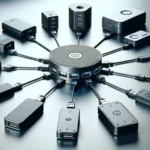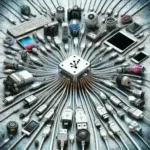Introduction
In today’s tech-driven world, the evolution of USB (Universal Serial Bus) technology has paved the way for new devices with improved efficiency and speed. With the advent of USB-C, many users find themselves questioning the compatibility of their older USB devices with this new standard. This article aims to clarify if USB hubs can effectively bridge the gap between USB-C devices and older USB ports, along with the various considerations involved.
Understanding USB Standards
Before delving into the specifics of USB hubs, it is essential to understand the different USB standards and their functionalities. Below is a table summarizing the key differences:
| USB Standard | Type | Speed | Power Delivery |
|---|---|---|---|
| USB 1.0 | A/B | 1.5 Mbps – 12 Mbps | No |
| USB 2.0 | A/B | 480 Mbps | No |
| USB 3.0 | A/B | 5 Gbps | No |
| USB 3.1 | A/B/C | 10 Gbps | Yes (up to 100W) |
| USB 3.2 | A/B/C | 20 Gbps | Yes (up to 100W) |
| USB4 | C | 40 Gbps | Yes (up to 240W) |
What is a USB Hub?
A USB hub is a device that expands a single USB port into multiple ports, allowing users to connect several USB devices simultaneously. USB hubs can be either powered or unpowered:
- Powered USB Hubs: These hubs come with an external power source and can provide additional power to connected devices.
- Unpowered USB Hubs: These hubs draw power directly from the host device and may not suitable for power-hungry peripherals.
Connecting USB-C Devices to Older USB Ports
A USB-C device can be connected to older USB ports through the use of a USB hub. However, there are several important considerations to take into account:
1. Compatibility
When connecting USB-C devices to older USB ports, compatibility is crucial. Most USB-C devices are designed to be backward compatible, which means they can work with earlier USB standards. Nonetheless, performance may be limited based on the capabilities of the older port. It is wise to check the specifications of the particular USB hub to ensure it supports USB-C connections.
2. Data Transfer Rates
Data transfer rates may be significantly reduced when connecting a USB-C device to an older USB port. For instance, while a USB 3.1 device can transfer data at speeds up to 10 Gbps, connecting it to a USB 2.0 port (which only supports 480 Mbps) will throttle the speed to the lower standard. It is vital to consider the intended use of the device when assessing performance:
| USB Version | Maximum Data Transfer Rate | Impact on USB-C Device |
|---|---|---|
| USB 2.0 | 480 Mbps | Significant speed reduction |
| USB 3.0 | 5 Gbps | Moderate speed reduction |
| USB 3.1 | 10 Gbps | Minimal speed reduction |
3. Power Supply Considerations
Power delivery is another critical aspect to consider when connecting USB-C devices to older USB ports. Many newer USB-C devices require more power than older standards can provide. If your hub is unpowered, it may not be able to supply sufficient power for charging or operating USB-C peripherals like external hard drives. Hence, a powered USB hub is generally recommended for optimal performance.
4. Adapter or Hub Choice
When selecting a hub or adapter, users should analyze the following options:
- USB-C to USB Adapter: This is a simple adapter that can allow for direct connection from a USB-C device to an older USB port. It is economical and straightforward, but lacks additional ports.
- USB Hub with USB-C Input: These hubs often offer multiple ports (including USB-C and older USB types), allowing for a broader connection range. This setup can maximize functionality and performance while ensuring compatibility.
Practical Examples
Here are some practical examples demonstrating the connections between USB-C devices and older USB ports:
Example 1: Connecting a USB-C External Hard Drive
If you own a USB-C external hard drive, you may connect it to a computer with a USB 2.0 port using a USB-C to USB adapter. However, the transfer speed will be significantly limited. Alternatively, using a powered USB hub that supports USB 3.0 or later will allow for faster data transfer rates.
Example 2: Using USB-C Headphones
USB-C headphones may be connected to an older USB port using an adapter, but again, you may experience audio latency or quality issues. If the older port doesn’t provide sufficient power, it may also affect the performance of the device.
Limitations and Drawbacks
While USB hubs can facilitate the connection of USB-C devices to older ports, there are inherent limitations:
- Devices may not function at optimal speeds due to backward compatibility.
- Power delivery limitations may hinder the functionality of certain power-hungry devices.
- Not all USB hubs are created equal; choose a quality hub that explicitly states compatibility with USB-C connections.
Future of USB Technology
The future of USB technology trends towards a move to standardize USB-C across all devices. This change is primarily driven by the superior data transfer capabilities and power delivery options that USB-C provides. As more manufacturers adopt this technology, fewer users will need to worry about compatibility issues with older USB standards.
Conclusion
In summary, USB hubs can indeed be used to connect USB-C devices to older USB ports, but several factors must be considered to ensure compatibility and performance. Users should prioritize powered USB hubs for power-intensive devices, recognize the limitations of backward compatibility regarding data transfer rates, and choose reputable adapters or hubs that suit their specific needs. Ultimately, while USB technology continues to evolve, bridging the gap between old and new standards gives consumers flexibility and usability as they adapt to modern advancements.


